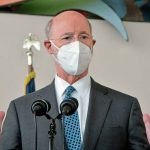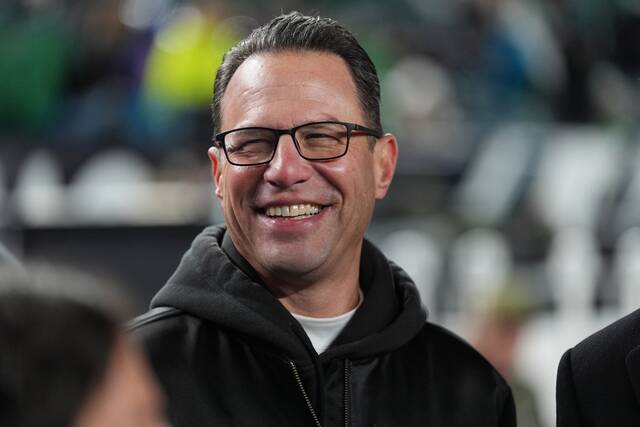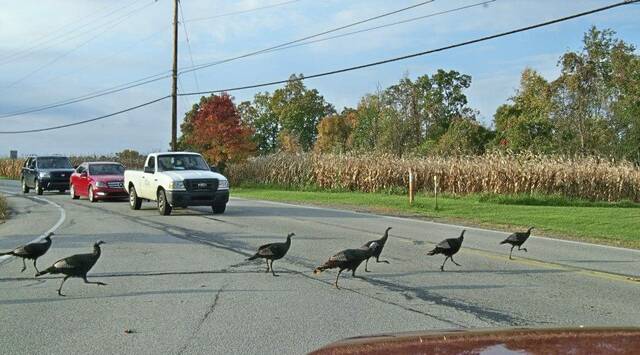Pennsylvania plans to lift its covid-19 mitigation orders on Memorial Day, and Gov. Tom Wolf said the state’s masking order will be dropped once 70% of Pennsylvanians 18 and older are fully vaccinated.
Mitigation measures that remain in effect until Memorial Day include capacity limits on restaurants, theaters, indoor and outdoor event spaces, and other businesses.
As of Tuesday morning, about 32.4% of all Pennsylvania residents were fully vaccinated and about 50% were partially vaccinated, according to data from the Department of Health. The U.S. Census Bureau reports about 20.6% (about 2.6 million) of the state’s residents are younger than 18. Factoring those people out, almost 40% of those 18 and older are considered fully vaccinated.
About 3.6 million Pennsylvanians are fully vaccinated, according to the department. Factoring out the state’s juveniles, there are about 10.2 million adults in the state. A 70% vaccination rate is about 7.14 million.
“We continue to make significant progress in the fight to stop the spread of covid-19 and as more Pennsylvania adults get vaccinated and guidance from the Centers for Disease Control and Prevention evolves, we can continue to move forward with our reopening efforts,” said Acting Pennsylvania Secretary of Health Alison Beam.
Last week, the department updated its mask mandate to fall in line with the CDC announcement indicating that those who are fully vaccinated can visit mask-free with other fully vaccinated people indoors and unvaccinated people outdoors.
Allegheny County Executive Rich Fitzgerald said Wolf’s announcements are a testament to the effort residents have put toward reducing the spread of the virus.
“As we continue to get vaccinations into arms, we are nearing 70% of our adult population in this county having at least one shot,” he said. “To know we can go back to normal after Memorial Day is great news.”
Requirements on testing and reporting new cases will remain in place for hospitals and long-term care facilities, officials said, and lifting mitigation measures will not keep individual municipalities and school districts from having their own, stricter guidelines.
Dr. Amesh Adalja, a Pittsburgh-based infectious disease and emergency medicine expert, said Wolf’s 70% vaccination metric will be difficult but doable.
“I think it’s going to be challenging, as we’re hitting a wall in terms of vaccine uptake,” he said. “I think it is something to aim for. I think by tying the ending of the mask mandate to a metric like that – it kind of shows people what a post-pandemic world could look like and what the benefit of the high vaccination level would be.”
Adalja, who is a senior scholar at Johns Hopkins Center for Health Security, said he believes it is safe for the rest of the state’s mitigation measures to be lifted. He pointed to Israel, which saw a dramatic drop in deaths and daily new case counts after reaching a vaccination rate of about 40%.
It’s a similar sentiment as that expressed by Dr. Tariq Cheema, Allegheny Health Network’s division director of pulmonary, critical care, allergy and sleep medicine.
He called 70% an “arbitrary number,” and said it’s impossible to say for certain whether 70% is the magic number that will cut off community transmission enough.
“Nobody knows where is that magic number where transmission stops,” he said, noting he hopes the promise of normalcy might encourage more people to get vaccinated.
Wolf’s announcement came the same day President Joe Biden outlined plans to get 70% of Americans at least one dose of the vaccine by July 4. He set a goal of getting 160 million Americans fully vaccinated by that point.
“You do need to get vaccinated,” Biden said from the White House. “Even if your chance of getting seriously ill is low, why take the risk? It could save your life or the lives of somebody you love.”
Cheema said people are “living in two different worlds right now: We have vaccinated people who can start getting back to normal. We have unvaccinated people who have to keep doing the mitigation measures.”
Dr. Graham Snyder, UPMC’s medical director of infection prevention and hospital epidemiology, said it’s important to remember that lifted restrictions do not mean the virus is gone or even that the pandemic is over. It is, after all, a global pandemic.
“What happens globally is really important for us, because we won’t be out of the pandemic even if things get better here,” he said. “Depending on the extent to which the virus evolves and has the opportunity to continue to spread – we may have to go back to interventions depending on what happens globally.”
He said individuals will still need to think critically about risk and what level of it they’re comfortable with.
“We’re shifting from prescriptive public health guidance to a way that you have to think a little bit more about what your own personal risk is,” he said.
That means people will need to make an assessment when it comes to masks, crowds and other situations in which the virus could spread – an assessment that might need to include not only one’s concern for themselves, but for vulnerable household members.
There are a variety of factors to consider, he said: the size of the group you’re with, how close everyone is, what you’re doing, whether others are vaccinated and whether they’re masking.
“All of that forms a continuum of risk,” he said. “If you want a very, very low level of risk in order to protect yourself or vulnerable people that are in your household, for example, then depending on the situation you probably still want to make sure you’re distancing.”















